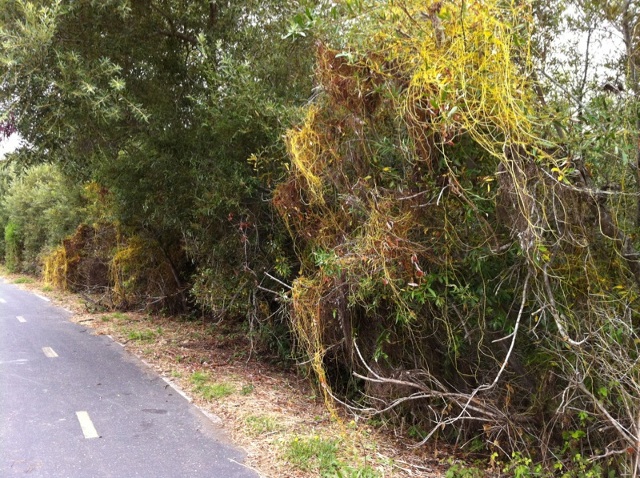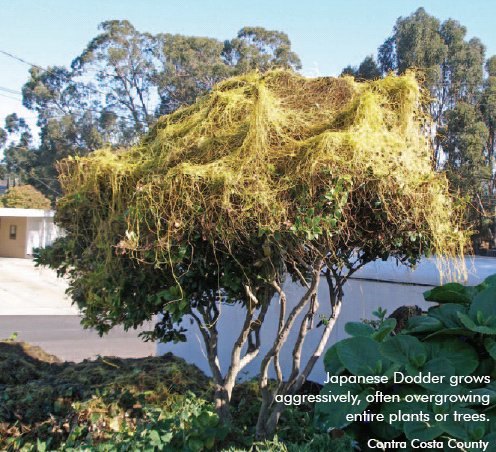Parasitic Plant Creeps Through Lompoc
Invasive Japanese Dodder Robs Hosts of Water and Nutrients

An invasive, parasitic plant — Japanese dodder (Cuscuta japonica) — was recently discovered in Lompoc, marking the first time the leafless vine has made an appearance in Santa Barbara County. Native to Southeast Asia, Japanese dodder is rated a “Class A Noxious Weed” by the federal Department of Agriculture, capable of quickly killing swaths of crop or vegetation if left unchecked. Infestations have occurred throughout the U.S. since 1941 when it was first introduced in Texas. Throughout California, the counties of Shasta, Sacramento, Fresno, Alameda, and Contra Costa have been hit particularly hard.
According to David Chang with Santa Barbara’s Agricultural Commissioner’s Office, “a botanically astute [Lompoc] citizen” reported seeing Japanese dodder in a patch of greenery south of Marigold Way, east of North V Street. A lab test confirmed the species, and Chang said his office is working on scheduling the eradication process. A few logistical hurdles need to be cleared before it can begin — such as coordinating with a contractor and the California Conservation Corps — but Chang said he hopes to launch a full attack in the next month or so. In the meantime, county staffers will conduct a “windshield survey” — driving around town and trying to spot additional dodder infestations — with door-to-door inquiries coming next.

Because dodder can grow as fast as four inches per day, Chang went on, the sooner his office can take care of the problem, the better. “You don’t want to leave this stuff sitting around,” he explained. “It can spread very easily.” Japanese dodder — which looks like a yellow/orange mass of tangled spaghetti — doesn’t produce its own chlorophyll, so must leech water and nutrients from a host plant, eventually killing it. Extremely hardy, a sprig of dodder can survive on its own for weeks before it sniffs out and attaches to another plant. It’s most often spread by nest-making animals, herbalists who cultivate it for its purported healing properties, and homeowners who use it as ornamentation in their gardens.
Chang said herbicides alone won’t put Lompoc’s dodder in check, and that the only way to clear the area is to cut the vine from its host plant or — if the host is too far infected — rip both from the ground. Right now, Chang explained, the dodder has attached itself to a large tree, which his office will try and save. A cluster of willows and a patch of poison oak will have to be eliminated, he said. Once the pesky plant is in the hands of eradicators, Chang went on, it’ll be transported to the county dump and buried. The site will then be watched to make sure nothing regrows.
Chang encouraged residents to contact his office ([805] 681-5600, sbcwma@agcommissioner.com) if they think they’ve spotted Japanese dodder anywhere in the county. The invasive species is distinct, however, from native dodder varieties, which are generally harmless and characterized by thinner, thread-like vines.


